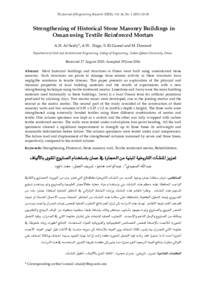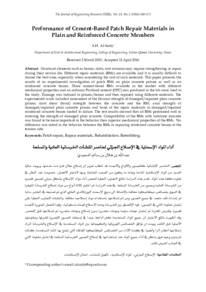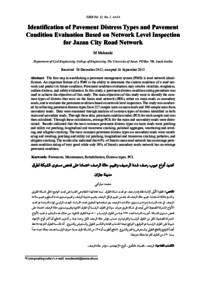وثيقة
Strengthening of historical stone masonry buildings in Oman using textile reinforced mortars.
المساهمون
الناشر
Sultan Qaboos University.
ميلادي
2017
اللغة
الأنجليزية
الملخص الإنجليزي
Most historical buildings and structures in Oman were built using unreinforced stone masonry. Such structures are prone to damage from seismic activity as these structures have negligible resistance to tensile stresses. This paper presents an exploration of the physical and chemical properties of local building materials and the results of experiments with a new strengthening technique using textile reinforced mortar. Limestone and Sarooj were the main building materials used historically in these buildings. Sarooj is a local Omani term for artificial pozzolana produced by calcining clays. Two mortar mixes were developed, one as the jointing mortar and the second as the matrix mortar. The second part of the study consisted of the construction of three masonry walls and two columns of 0.35 x 0.25 x 1.2 m (width x depth x height). The three walls were strengthened using externally bonded textiles using three different combinations of mortar and textile. One column specimen was kept as a control and the other was fully wrapped with carbon textile reinforced mortar. The walls were tested under out-of-plane four-point bending. All the wall specimens showed a significant improvement in strength up to three times its self-weight and reasonable deformation before failure. The column specimens were tested under axial compression. The failure load and displacement of the strengthened columns increased by seven and three times, respectively, compared to the control column.
المجموعة
ISSN
1726-6742
URL المصدر
zcustom_txt_2
Al-Saidy, A. H., Hago, A. W., ElGamal, S., & Dawood, M. (2017). Strengthening of historical stone masonry buildings in Oman using textile reinforced mortars. The Journal of Engineering Research, 14 (1), 23-38.
الملخص العربي
تزخر سلطنة عمان بوجود العديد من المنشآت التاريخية كالقلاع التي تعتبر جزء من الموروث الحضاري والثقافي الواجب المحافظة عليه. معظم هذه المنشآت بني باستخدام مواد محلية كالأحجار الطبيعية والصاروج ولم يستخدم تسليح لتدعيم هذه المنشآت. ونظرا لتقادم هذه المنشآت وزيادة النشاط الزلزالي في المناطق المحاذية لسلطنة عمان ؛ بات من الضروري إيجاد الحلول الكفيلة بالمحافظة على سلامة هذه المنشآت من المخاطر المحتملة بسبب الأحمال المفاجأة أو نتيجة للضعف العام نتيجة التقادم. تهدف هذه الدراسة إلى إبراز أهم نتائج التجارب العملية لفحص عينات لجدران وأعمده بنیت من الحجر الجيري والصاروج وتم تدعيمها بأسلوب مبتكر وذلك بإضافة طبقة سطحية مكونه من ألياف الزجاج والكربون وملاط من الصاروج والرمل الناعم والإسمنت. التجارب العملية اشتملت على اختبار مقاومة الثني في الجدران، وقوة التحمل المحورية للأعمدة بالإضافة لفحص الخصائص الكيميائية والفيزيائية للمواد المستخدمة. النتائج أظهرت زيادة ملحوظة في مقاومة الثني للجدران بما يقرب ثلاثة أضعاف وزن العينة بالإضافة إلى مرونة مناسبة في الانثناء قبل انهيار العينة. الأعمدة المعززة أبدت أداء متميزا فقد زادت قوة التحمل المحورية كما زادت إزاحة نهاية العمود بسبعة أضعاف وبثلاثة أضعاف على التوالي مقارنة بنتائج العينة المرجعية الغير معززة مما يشير إلى كفاءة طريقة التعزيز المستخدمة في هذه الدراسة.
قالب العنصر
مقالات الدوريات



